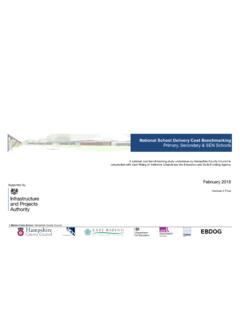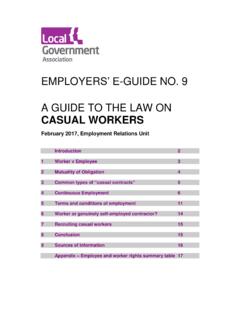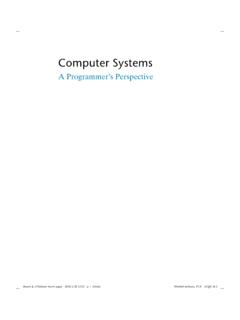Transcription of Devolution in the UK: Historical Perspective Dr. Andrew ...
1 1 Devolution in the UK: Historical Perspective Dr. Andrew blick , King s College London This paper considers the current territorial distribution of political authority within the United Kingdom (UK), and prospects for the future, from an Historical Perspective . It discusses the uneven and diverse ways in which UK governance has developed, how they have led to the present position, and what the consequent trajectories of development might be. The author also considers whether the analysis of specific circumstances or tendencies from the past may enhance our understanding of contemporary issues.
2 The overall purpose of the paper is to answer the questions: how did we get where we are now, and what guidance might past patterns of development offer for the future? It begins by considering the nature of the UK as a multinational, union state, and the constitutional implications. Next it discusses the history of Devolution , both as a concept and a practical reality, the different models employed, and the particular issues that arise. Finally, it assesses what might be the range of options of the future development of Devolution in the UK, based on the patterns to date.
3 A multinational union The UK came into being (and then lost some of its territory) in a series of bilateral actions. England fully absorbed Wales in the mid-sixteenth century. Scotland and England entered into a union, forming the United Kingdom of Great Britain, in 1706-1707. The Act of Union between Great Britain and Ireland was passed in 1800, creating the United Kingdom of Great Britain and Ireland. The departure of most of Ireland in the 1920s led eventually to the adoption of a new name for the country, the United Kingdom of Great Britain and Northern Ireland.
4 The terms of each incorporation differed, and throughout its history pronounced territorial variety of constitutional arrangements has characterised the UK. These divergences have included: Different official religions (in England and Scotland), or no official religion at all (disestablishment took place in Ireland under the Irish Church Act 1869, and in Wales under the Welsh Church Act 1914); Multiple legal systems (for England and Wales; Scotland and [Northern] Ireland. There has also been discussion recently of fully establishing a separate legal jurisdiction for Wales); Different systems of local government; and Varied systems of ministerial and departmental responsibility for different territories within the UK.
5 Against this background, the asymmetry of present arrangements for the governance of the UK, though they may be novel in their particular form, are in keeping with longer 2 established patterns of general divergence. Furthermore, proposals for future change could contain within them the retention of diversity of some kind and at the same time be within long-term tendencies in the configuration of the UK constitution. Asymmetry is the norm. Perhaps the question is what type of asymmetry is to be adopted. This quality arises from underlying tensions in a state of such heterogeneous composition, and within which one unit, England, is far larger in population terms than the others combined.
6 Yet centrifugal pressures are not always of equal force; they can both rise and recede. At times in the twentieth century for instance, during the 1950s nationalism in Scotland and Wales did not seem as dynamic as it did in other periods. Devolution Devolution (or Home Rule ) has been a recurring item on the UK political agenda at least as far back as the First Home Rule Bill introduced by the then Prime Minister, William Gladstone, in 1886 (formally known as the Government of Ireland Bill). While the initial impetus came from Ireland, the idea developed that it might be appropriate to extend Home Rule to other parts of the UK ( Home Rule All Round ).
7 There was significant political resistance to the idea of Devolution in Westminster, and it was not implemented until 1921, and then only for Northern Ireland, under the Government of Ireland Act 1920. This system survived until it was suspended in 1972. Successive attempts to restore Devolution to Northern Ireland failed, until the Belfast (or Good Friday ) Agreement of 1998 made its reintroduction possible, with statutory enactment under the Northern Ireland Act 1998. In the meantime, partly as a consequence of the work of the Royal Commission on the Constitution, which reported in 1973, the Labour governments of 1974-1979 attempted, rather unenthusiastically, to introduce Devolution to Wales and Scotland.
8 But this effort was unsuccessful. It did not receive the required levels of support when referendums were held in the territories concerned. In Scotland, while there was a simple yes majority, the requirement of support from 40 per cent of those who were able to vote was not met. In Wales, Devolution was rejected outright. After returning to office in 1997, Labour held referendums on Devolution for Scotland and Wales, on the reintroduction of self government to Greater London, and on the Good Friday Agreement. All were approved. Acts of Parliament then facilitated devolved systems in all these territories.
9 They have generally expanded their powers since this point (though Devolution in Northern Ireland has been subject to prolonged suspension). However, Labour Devolution policy was less successful in another area. The government intended while not making the plan a priority to introduce directly elected assemblies to the eight English administrative regions outside Greater London. However, the project met a decisive setback in 2004 when voters in the first referendum, in the North East region, rejected the plan. English Devolution has now become a live issue once more under the present Conservative government with its development of deals with combined or individual local authorities.
10 A consideration of the historic development of Devolution as a concept and practical reality suggests certain observations: Devolution has been intrinsically bound up with political tension, controversy, division, and even violent conflict. It has arisen out of demands for more self-government, or as an attempt to avert nationalist movements that might threaten the union. In the case of Northern Ireland in 1921, the system ultimately introduced was an unintended and unforeseen culmination of a complex and violent interaction of forces. The idea of Devolution when proposed has been criticised both by those who feel it is a dangerous erosion of the fabric of the UK, those who regard it as not providing sufficient autonomy, and those who regard it as an unwanted imposition.

















